02.05.2006
Sergey Klimov. Dagomys Cutting (rounds 4-7)
In the beginning of the report I would like to draw your attention to some interesting opening ideas.
Opening
Potkin-Kharlov
1.d4 ¤f6 2.c4 e6 3.¤f3 d5 4.¤c3 dxc4 5.e4 Ґb4
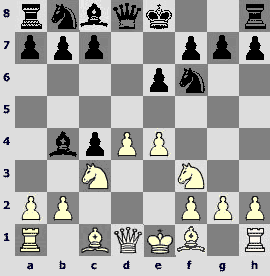
6.Ґxc4!?
This move turns out playable!
6...¤xe4 7.0-0 ¤xc3 8.bxc3 Ґe7 9.¤e5
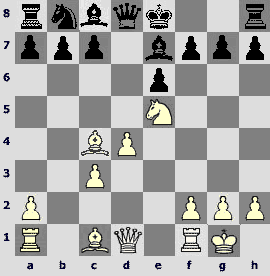
With White having only two tempi for a pawn it is difficult to see sufficient compensation.
9...0-0 10.Јg4 ¤c6 11.Ґh6 Ґf6 12.f4 ¤e7 (Kharlov carried out a similar knight maneuver playing against Mamedyarov in the previous round) 13.¦ae1 c5 14.Ґg5 ¤f5 15.dxc5 Ґxg5 16.fxg5 Јc7 17.c6 bxc6
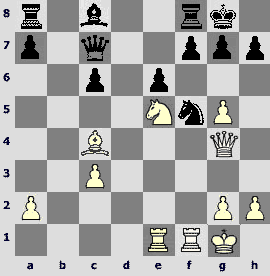
18.¦f3 Ґa6 19.Ґxa6 Јb6+ 20.ўh1 Јxa6 21.¤d7
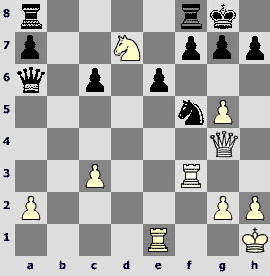
21...Јxa2
Now it turns out that Black must part with an exchange: 21...¦fd8 22.¤f6+ ўh8 23.Јh5 (23.¤xh7 ўxh7 24.Јh5+ ўg8 25.¦h3 ўf8) 23...gxf6 24.¦h3 h6 25.g4 Јxa2 26.gxf5 Јd5+ 27.¦f3 fxg5 28.c4+-.
22.¤xf8 ¦xf8 23.¦d3 Јa5 24.¦ed1 ¤e7 25.c4 ¤f5 26.Јf4 - the material is balanced, and the game was drawn soon.
Jakovenko-Bareev
1.e4 e6 2.d4 d5 3.¤c3 ¤f6 4.e5 ¤fd7 5.f4 c5 6.¤f3 ¤c6 7.Ґe3 a6 8.Јd2 b5 9.a3
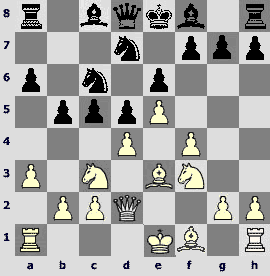
9...g5
A fruitful opening idea of Alexander Morozevich.
10.fxg5
10.dxc5 gxf4 11.Ґxf4 Ґxc5 12.a4 Јa5 13.Ґd3 Ґb7 14.¤e2 Јxd2+ 15. ўxd2 bxa4 Froljanov-Volkov, Sochi, 2005;
10.¤xg5 cxd4 11.Ґxd4 ¤xd4 12.Јxd4 Ґc5 13.Јd2 Јb6 14.g3 ¤xe5 15.Јe2 Ґe3 16.¤xe6 fxe6 17.fxe5 ¦f8„ А.Ivanov-Linchevsky, Petersburg 2005.
10...cxd4 11.¤xd4
The pioneer game Anand-Morozevich, Monaco 2005 continued 11.Ґxd4 Ґg7 12.0-0-0 0-0 13.¤a2 ¤xd4 14.¤xd4 ¤xe5 15.h4 ¤c4 16.Ґxc4 bxc4 17. ўb1 ¦b8.
11...¤cxe5 12.Ґd3

…¤c3-e2-g3-h5
12...Ґg7N
As far as my database knows, it is a novelty. Motylev-Volkov (Russian superfinal) saw 12...Ґb7 13.0-0 Јc7 14. ўh1 Ґg7 15.¦ae1 0-0 16.¤ce2 ¤c4 17.Ґxc4 dxc4 18.¤g3 c3 19.bxc3 ¦ac8. Bareev saves time on Ґb7, as Black sometimes can do without it.
13.¤ce2 0-0 14.¤g3 ¤xd3+!?
Another difference compared to the aforementioned game: instead of playing ¤c4, Black simply exchanges the knight.
15.cxd3
Of course, White has no intention of putting the queen under attack – 15.Јxd3 ¤e5 16.Јe2 ¤c4.
15...Јb6 16.Јf2
A direct offence yields White nothing: 16.¤df5 d4 17.¤xg7 dxe3 18.Јc3 Јc5 19.¤7h5 Јxg5.
16...f5
Creating a threat f4 and defending against ¤g3-h5-f6.
17.¤f3
Not good is 17.¤h5 in view of 17...f4! 18.¤xf4 Ґxd4 19.Ґxd4 Јd6 20.Ґf6 ¤xf6 21.gxf6 Јe5+ (but not 21...¦xf6 22.Јg3+±).
17...Јb8
17...Јd6 looked more natural, but it looks like Black does not want to place his queen on the a3-f8 diagonal.
18.¤h5 f4 19.Ґd4 e5 20.¤xg7 ўxg7 21.Ґc3 ўg8
21...d4 22.¤xd4±.
22.0-0 d4 23.Ґa5
Not good is 23.¤xd4? because of 23...exd4 24.Јxd4 Јb6.
Frankly speaking, one wants to try another idea here – play g6 at some point, then ¤g5 and Јh4:
23.Ґb4 ¦e8
A) 24.g6 hxg6 25.Јh4 a5 (the line 25...Јb6 26.¤g5 ¤f6 27.Јh6 Ґf5 28.g4 Ґxd3 29.¦f3 is more a dream than reality) 26.¤g5 (26.Ґe7!?) 26...¤f6 27.Јh6 Јb7 – well, it did not work out.
B) Neither 24.Јh4 a5 25.Јh5 ¦e6 promises anything good.
C) 24.¦ac1 Јb6.
23...Ґb7 24.¦ac1 ¦c8 25.Ґb4
However, in this situation playing g6 is more justified, because another black piece – a rook – has left the kingside. 25.g6 hxg6 26.¤g5 ¤f6 27.Јh4 Ґd5 (27...Јd6 28.Јh6 Јf8 29.Јxg6+ Јg7 30.Јf5) 28.Јh6 Јb7 29.Јxg6+ Јg7 30.Јf5
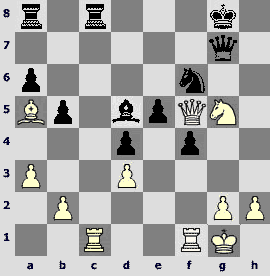
– the Black's pawnless king looks kind of naked.
25...a5 26.Ґe7 ¦a6 27.¦xc8+
27.¤h4 ¦ac6.
27...Јxc8 28.¦e1 ¦e6 29.Ґf6 Јe8 30.Јe2 Ґxf3
30...Јh5 31.¤xd4 Јxe2 32.¦xe2 ¦xf6 33.gxf6 exd4 34.¦e8+ ¤f8 35.¦e7 Ґc6 36.¦g7+ ўh8 37.¦g5І.
31.Јxf3 ¤xf6 32.gxf6 ўf7 33.Јh5+ ўxf6 34.Јxh7 Јg6 35.Јh3 Јf5 36.Јf3І
The Black's king it too weak for a position with heavy pieces. Jakovenko made a good use of it and proceeded to a win (1-0).
Asrian-Jakovenko
1.e4 e5 2.¤f3 ¤c6 3.Ґb5 ¤f6 4.0-0 ¤xe4 5.¦e1 ¤d6 6.¤xe5 ¤xe5 7.¦xe5+ Ґe7 8.Ґf1 0-0 9.d4 b6
Maybe in view of this game playing 9...Ґf6 10.¦e1 ¤f5 will be considered more accurate.
10.¤c3
Normally White plays 10.Ґf4 either immediately or after retreating the rook to e1.
10...Ґf6 11.¤d5!?
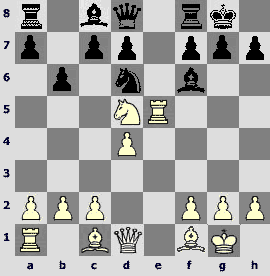
Surprise!
11...Ґb7
Black did not dare to take an exchange: 11...Ґxe5 12.dxe5. Now he can't go forward: 12...¤f5 13.Јg4 d6 14.Ґg5 h5 (14...Јd7 15.¤f6++-) 15.Јxh5+-, and 12...¤e8 13.Јh5 …Ґb7 14.Ґg5 also looks scary.
12.¤xf6+ Јxf6 13.Ґd3 h6 14.Јg4ѓ,
and White got an advantage in a completely dull-looking variation.
14...¦ae8 15.Ґf4 Ґe4 16.Ґxe4 ¤xe4 17.¦e1 d5 18.f3 ¦xe5 19.Ґxe5 Јg5 20.Јf4 Јxf4 21.Ґxf4 ¤g5 22.Ґxg5 hxg5 23.¦e5 ¦d8 24.¦xg5 – Black suffered to make a draw. Also, I don't think he could survive after 23.¦е7.
Mamedyarov-Kharlov
1.d4 d5 2.¤f3 e6 3.c4 dxc4 4.e3 c5 5.Ґxc4 a6 6.0-0 ¤f6 7.Ґb3 cxd4 8.exd4 ¤c6 9.¤c3 Ґe7 10.Ґg5 0-0 11.¦c1!?
In recent years 11.Јd2 has become almost automatic.
11...¤d5N
The critical continuation here is 11...¤a5 12.Ґc2 or 12.Ґxf6.
12.Ґe3!?
12.Ґxd5 is another interesting possibility here. 12...Ґxg5 13.¤xg5 Јxg5 (maybe 13...exd5 is simpler – White has a good structure, but the knight is clearly misplaced) 14.Ґxc6 (14.Ґf3 ¦d8) 14...bxc6 15.Јf3 (15.¤e4 Јd5) 15...¦b8 16.b3 Ґb7.
12...¤xc3 13.¦xc3
More standard is another capture, 13.bxc3.
13...¤b4 14.¤e5 ¤d5 15.¦c1 Ґd7 16.Јg4 Ґb5 17.Ґh6 Ґf6 18.¦fe1

18...¤e7
Taking further course of the game into account, this move fails to impress. 18...¦c8 deserves attention.
19.Ґd2 Јd6
Not good is 19...¤g6 because of 20.Ґb4 (20.¤xg6 hxg6 21.¦xe6? Ґd7) 20...Ґe7 (20...¦e8 21.¤xf7+-) 21.¤xg6 hxg6 22.Ґxe7 Јxe7 23.d5 e5 24.a4 Ґd7 25.¦c7±;
19...¤f5 just does not look right: 20.d5 (20.¤xf7 ¦xf7 21.Ґxe6 ¤xd4; it is possible that simple 20.Ґc3 is even stronger) 20...¤e7 21.a4 Ґe8 22.Ґb4 (22.dxe6 Ґxe5) 22...exd5.
20.¤xf7! ¦xf7
After 20...Јxd4 Black seems to stay in the game: 21.Јxd4 (21.Јxe6 Јxd2 – there is no smothered mate, because Black can take on g8 with the knight; one could try 21.¤h6+ ўh8 22.Ґc3 in order to take on e6 later) 21...Ґxd4 22.¦xe6 ¤c6 – it looks unpleasant for Black, however, he not only does not lose any more material, but also threatens to regain the pawn.
21.¦xe6 Јd7
21...Јxd4 22.Јxd4 Ґxd4 23.¦xe7.
22.¦xf6! Јxg4 23.¦xf7+-
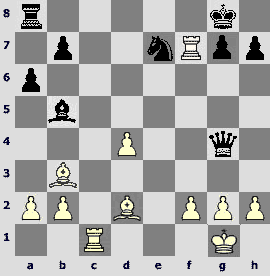
23...ўh8 24.¦xe7 ¦c8 25.¦xc8+ Јxc8 26.d5
In view of two main threats, Ґc3 and d6, Black resigned.
In the following game White invented a novelty in quite a topical variation of the Rauzer attack with 8...Јb6. Black's reaction looks accurate to me, however, then he misplayed and lost to a nice tactics noticed by Motylev.
Motylev-Iskusnykh
1.e4 c5 2.¤f3 d6 3.d4 cxd4 4.¤xd4 ¤f6 5.¤c3 ¤c6 6.Ґg5 e6 7.Јd2 Ґe7 8.0-0-0 Јb6 9.¤db5
White is reluctant to retreat on b3, while after 9.f4 Јxd4 10.Јxd4 ¤xd4 11.¦xd4 drawing tendencies prevail.
9...0-0 10.Јe1N
10.f4 occurred in Motylev's games with both colors.
10...a6
In my opinion, 10...¦d8 is rather critical, and after 11.Ґxf6 one can even play 11...Ґxf6 12.¤a4 Јa6.
11.¤xd6 ¤e5 12.¤c4
12.Јe3 looksokay: 12...Јc7 (12...Јxe3+ 13.Ґxe3 ¤fg4 14.Ґb6 ¤d7? 15.¤xc8+-) 13.Јg3 ¦d8 14.Јxe5 ¦xd6 15.Ґxf6 gxf6 16.Јg3+ ўh8 17.Ґd3.
12...¤xc4 13.Ґxc4 Јc5
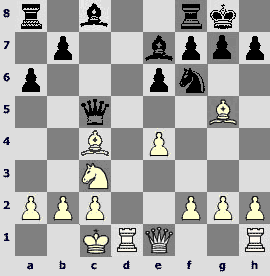
14.e5 Јxc4 15.exf6 Ґxf6 16.Ґxf6 Јf4+ 17.Јe3 Јxf6 18.¦d6 b5 19.¤d5 Јh4 20.g3
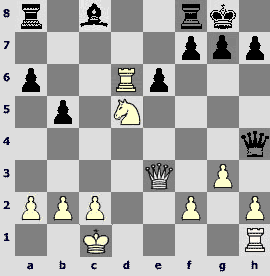
20...Јa4??
After 20...Јh3 the position is balanced.
21.¤f6+!+- ўh8
21...gxf6 22.¦d4 Јxa2 23.¦g4+ ўh8 24.Јh6+-.
22.¦d4 Јxa2 23.¦h4 Јa1+ 24. ўd2 Јa5+ 25. ўe2 1-0
Kasimjanov-Rublevsky
1.e4 c5 2.¤f3 e6 3.d4 cxd4 4.¤xd4 ¤c6 5.¤c3 a6 6.¤xc6 bxc6 7.Јd3!?
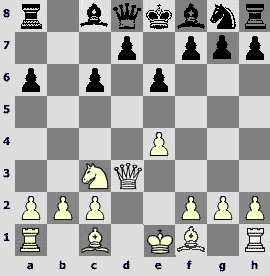
A new idea to transfer the queen to g3 at once.
7...Јc7 8.Јg3 (nevertheless) 8...Јxg3 9.hxg3 d5 10.Ґf4 ¤f6 (this particular endgame is okay for Black) 11.¤a4 Ґb4+ 12.c3 Ґa5 13.exd5 cxd5 14.Ґe5 Ґd7 15.¤c5 Ґb5 16.Ґxb5+ axb5 17.¤b7 ўe7 18.¤xa5 ¦xa5 19.a3 ¤e8=Ѕ-Ѕ
Due to specific nature of internet-commentary (the analyst covers many games in very limited time, having the only advantage of being able to consult with the engine) it often reveals that innocent-looking moments of struggle actually played a key role.
For instance, in the following game something very surprising happened: Vladimir Akopian, having Black against Anatoly Karpov, won in the smoothest fashion as if it had been programmed, without any obvious blunders by White. First the Armenian established the control over dark squares, then seized the initiative, made a nice intuitive pawn sacrifice and won by attacking a vulnerable f2-square.
It all looks right, but I have questions: why
1) White played so strangely in the middlegame, moving his pieces back and forth?
2) Got absolutely nothing out of the opening?
3) Played e3-e4, leaving dark squares to Black, and then worsened the situation by provoking c6-c5?
Sergey Shipov enlightens the ChessPro reader on the events after the 21st move, and I would like to draw your attention to the first half of the game.
1.d4 d5 2.c4 c6 3.¤f3 ¤f6 4.e3 Ґf5 5.¤c3 e6 6.¤h4 Ґg6 7.¤xg6 hxg6 8.h3
A rare move. Previously Karpov preferred 8.g3
8...¤bd7 9.Ґd2 Ґd6 10.Ґd3
10.¦c1!?; 10.c5!?
10...dxc4 11.Ґxc4 0-0 12.0-0
The castling looks a bit early to me. 12.Јc2 deserves attention.
12...e5 13.dxe5 ¤xe5 14.Ґe2 g5!?
The move containing two ideas:
– to prevent e3-e4 and f2-f4;
– to play g5-g4 with attack on occasion.
15.e4
Considering the future events, one becomes reluctant to accept this move – it weakens dark squares, while the Black's knight can always improve its location later. However, the problem is that White has difficulties with active development. 15.Јc2 is well met by 15...g4 16.hxg4 ¤exg4.
15...¤h7
15...¤fd7 16.Ґxg5
16.Ґe3 Јe7 17.Јc2 ¦fd8
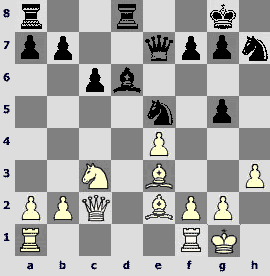
Here White initiates a fruitless maneuver of the knight forth to c5 and back to b3.
18.¤a4
It looks unimpressive, but I cannot see a reasonable alternative, to be honest. Maybe one should try to carry out f2-f4: 18.g3 ¤f8 (18...Ґc5 19.¤d5І) 19. ўg2 ¤e6 20.f4 (20.¦ad1 Ґc5=) 20...gxf4 21.gxf4 ¤g6 22.Јc1, however, after this advance Whtie's position becomes very shaky.
Finally, one can play 18.a3 ¤f8 19.b4, which looks better to me, for example, 19...¤e6 20.¦fd1 ¤f4 21.Ґf1.
18...¤f8 19.¤c5
19.g3 ¤e6 20.f4? (20.¦ad1) 20...gxf4 21.gxf4 Јh4 22. ўg2 ¤g6µ.
19...b6 20.¤b3 ¤e6 21.¦fd1 c5
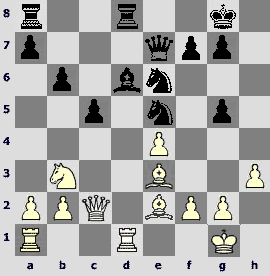
22.a3
In one of Mark Dvoretsky's books Evgeny Bareev exclaims: "A typical Karpov! Only having understood what he is preventing, I realized what I am aiming at!" The text-move is highly mysterious – after all, b2-b4 is hardly desirable at all!
If I understand Karpov's logic correctly, White has no useful moves here, therefore Karpov creates a route for his worst piece – the b3-knight. After ¤b3-c1-a2-c3 it may eventually end up on b5.
22...a5 23.¤d2
23.¤c1 ¤c6
23...¤d4 24.Ґxd4 cxd4і 25.¤f1 ¦ac8 26.Јb1
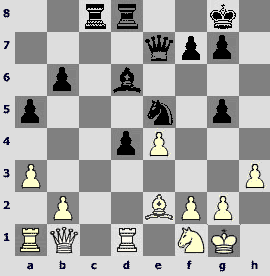
26...d3!? 27.Ґxd3 Ґc5 28.Ґa6 ¦c6 29.¦xd8+ Јxd8 30.Јd1 ¦d6

31.Јb3
(31.Јe2 g4ѓ)
31...¦f6 32.Јd5 (32.¤e3 Јd2) 32...Јc7 33.b4 Ґxf2+µ 34.ўh1 g4 35.¦d1 ўh7 36.Јd8 Јc3 37.Јc8 ¦f3 38.¤h2 Јxc8 39.Ґxc8 ¦xa3 40.bxa5 g3 41.¤f3 ¤xf3 42.gxf3 ¦a2 43.ўg2 Ґe1+ 44.ўf1 Ґb4 45.¦d5 g2+ 46.ўg1 Ґc5+
0-1
Tothefight
It is innate desire to fight that forces certain young and very talented players seeking complications in the most harmless positions for the sake of it.
Potkin-Mamedyarov
1.e4 e5 2.¤f3 ¤c6 3.Ґb5 a6 4.Ґxc6 dxc6 5.0-0 Ґg4 6.h3 h5 7.d3 Јf6 8.¤bd2 Ґd6 9.¦e1 Ґxf3 10.Јxf3 Јe6 11.¤c4 ¤e7 12.Јg3
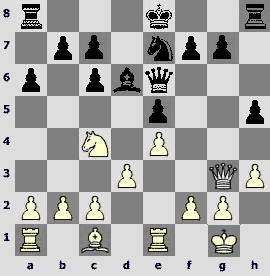
12...g5?!
Just like that – under two captures.
13.Јxg5 0-0-0 14.f4
14.Јe3 ¦dg8.
14...f6 15.Јh4 ¤g6 16.Јf2 exf4 17.¤xd6+ Јxd6 18.¦f1 ¦hg8
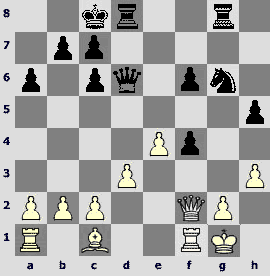
19. ўh1
A mysterious moment. Why White refused to play 19.Ґxf4? I cannot understand it. Black cannot regain even a pawn in this case: 19...¤xf4 (19...Јe6 20.Ґd2 …Јf6 or Јf5) 20.Јxf4 Јd4+ 21.¦f2 Јxb2 22.Јxf6.
19...f3 20.Јxf3
Here taking on f3 with the pawn 20.gxf3 is indeed risky, as the king becomes very weak.
20...¤h4 21.Јf4
21.Јxf6? ¦df8-+; 21.Јxh5 Јg3‚.
21...¦xg2 22.Јxd6 cxd6 23.¦f4 ¦dg8 24.Ґe3 ¦2g3 25.¦xh4 ¦xe3 26.¦xh5 ¦e2 27.¦c1 ¦gg2, and Black even played for a win for a while, although without much success.
Brodsky-Volokitin
1.d4 ¤f6 2.c4 e6 3.¤f3 c5 4.d5 d6 5.¤c3 exd5 6.cxd5 g6 7.e4 a6 8.h3 b5 9.Ґd3 Ґg7 10.0-0 0-0 11.a3 ¤bd7 12.¦e1 Јe7 13.Ґf4 ¤h5
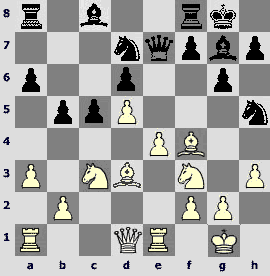
14.Ґg5 Ґf6 15.Ґh6 Ґg7 16.Ґg5 Ґf6 17.Ґh6 ¦e8 18.Јd2 Ґg7 19.¦ad1 (on 19.Ґg5 Black would probably play 19...Јf8) 19...Ґxh6 20.Јxh6 Јf6 21.¦e3 ¤e5 22.Ґf1 Ґd7 23.¤h2 (as it often happens in Indian structures, the e5-knight stands well but shaky, in view of the forthcoming f2-f4. Black prepares to sacrifice it to prove the strength of his position) 23...b4 24.¤b1 ¦ab8 25.b3 a5 26.g3 a4 27.f4
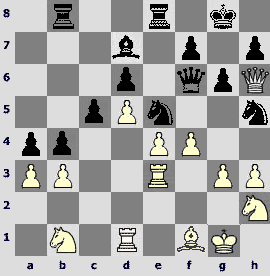
27...axb3 28.Ґe2 bxa3 29.¤xa3 b2 30.fxe5 ¦xe5 31.¤g4 Ґxg4 32.hxg4 ¤g7 (Sergey Shipov's suggestion 32...¤xg3 33.¦xg3 ¦xe4 gives some nebulous practical chances) 33.Јf4 Јe7 34.¦b1 ¦e8 35.¤c4 ¦xe4 36.¦xe4 Јxe4 37.Јxe4 ¦xe4 38.¦xb2+-, and White wins.
Areshchenko-Volokitin
1.e4 e5 2.¤f3 ¤f6 3.¤xe5 d6 4.¤f3 ¤xe4 5.d3
Unpretentious but solid.
5...¤f6 6.d4 d5 7.Ґd3 Ґe7 8.h3 0-0 9.¤c3
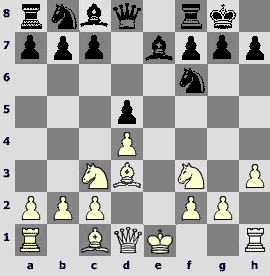
As far as I understand, Black usually plays ¤bd7, ¦e8, ¤f8 etc. in such positions.
9...b6!?
Disturbing symmetry at all costs.
10.0-0 Ґa6 11.Ґxa6 ¤xa6 12.¤e5І
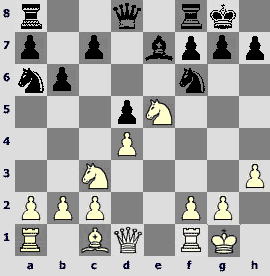
12...h6 (offering to exchange the e7-knight) 13.Ґf4 ¦e8 14.Јf3 ¤b4 15.¦ac1 c5 16.a3 ¤a6 17.¦cd1 ¤c7 18.dxc5 Ґxc5 (here it seems Black will have to suffer for a draw) 19.¤g4 ¤xg4 20.Јxg4 d4 21.b4 Јc8 22.Ґxc7 dxc3 23.¦d7 Ґf8

24.Јd4 ¦e2 25.¦d8 Јb7 26.¦xa8 Јxa8 27.Јxc3 Јe4 28.¦c1 Ґe7 29.Јd3 Јxd3 30.cxd3 ¦a2 31.d4 ¦xa3 32.¦d1 ¦c3 33.Ґb8 Ґxb4 34.Ґxa7 ¦c6 35.Ґb8 ¦f6 36.Ґc7 b5 37.Ґe5 ¦b6 38.d5 Ґd6 39.Ґxd6 ¦xd6,
and Volokitin tortured his opponent for 40 more moves.
Unusual moves
The inventor of 1.e4 c5 2.¤a3, Vadim Zvjaginsev is still the main supplier of original moves in this tournament.
Rublevsky-Zvjaginsev
1.e4 c5 2.¤f3 ¤c6 3.Ґb5 e5
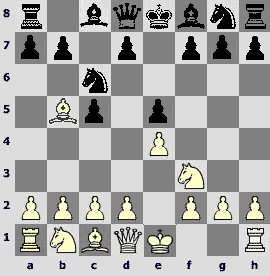
Itoccursquiterarely. Normally Black plays 3...e5 after 3.¤c3, when White has to lose time for c3 and d4.
4.0-0 ¤ge7 5.Ґc4 ¤g6 6.c3 Ґe7 7.d4 cxd4 8.cxd4 d6 9.d5 ¤b8 10.¤c3 0-0 11.Ґe3 a6 12.¦c1 Ґg4 13.Ґe2 ¤f4 14.¤d2 Ґxe2 15.¤xe2
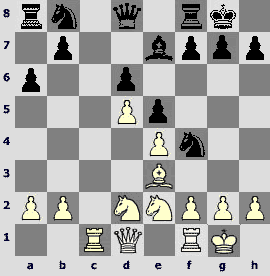
15...Ґg5
Here one could play 15...¤xe2+ 16.Јxe2 ¤d7 and end up in a slightly worse position. However, Black invents something non-standard and rather unsound.
16.¤xf4 exf4 17.Ґd4 f3 18.g3 ¤d7 (18...f5!?) 19.¦c3 ¦e8 20.¦e1 ¤f6 21.¦xf3 ¦c8 22.h4 Ґxd2 23.Ґxf6 Јa5 24.¦a3 Јb4 25.Јg4 g6 26.¦b3 Јc4 27.¦e2±, and White proceeded to a win
